First some Side Notes
|
First some Side Notes
|
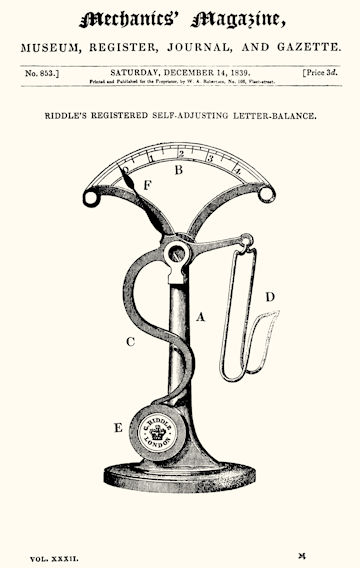 Fig. 1: Riddle's Registered Self-Adjusting Letter-Balance [13] |
IntroductionIn August 2020 I saw a mediocre photo on a Dutch auction site in which I thought I recognized a Riddle. I made an offer and this was accepted the same day. After a few days, the postal service delivered the package. Quickly unpacked and yes: most likely a Riddle! After carefully examining this letter scale, I took photos from all sides and all the details. I consulted the Handbook of old weighing instruments by Michael Crawforth [1] and searched back issues via the Equilibrium index [2] for information about G. Riddle. I also searched left and right on the internet [3] and found some more information. The weekly journal Mechanics' Magazine from the period 1830-1841 provided a lot of interesting information [4]. I contacted Diana Crawforth-Hitchins and Carol Hayden. Both ladies were immediately willing to help me with an article about Riddle. Diana sent me two pages of her data about Riddle and his family. At that time I was not yet ready to start writing, but I thought writing should be feasible by the middle or end of 2021. I already made a web page about my Riddle letter scale [5]. After that I occasionally searched further on the internet and came across new details. In mid-2023 I finally got into the right mood to write the article. I again contacted Diana Crawforth-Hitchins. Diana sent me a new, more extensive list of her Riddle data, this time no less than eight pages [6]. In that list I saw that Gregg Motter also owns a Riddle letter scale. I contacted him and he also helped me. The article below is the result of the information collected about Riddle's scales. It also discusses, among other topics, Riddle's private life, his business relationship with Sampson Mordan, Riddle's products and his bankruptcy. | 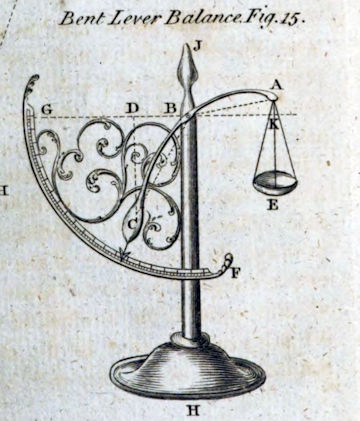 Fig. 2: an old bent lever balance from the book an introduction to natural philosophy, by William Nicholson, 1805, between pp 60-61 |
The first letter scales in England were made as early as 1839. The announcement and introduction of the English Postal Reform Act in 1840 (Sir Rowland Hill's Uniform Postal Act) can be regarded as the catalyst for the development of letter scales (also called letter balances, or letter weighing machines, or letter weights, or postal scales or postal balances). From now on, the shipping costs of letters will be determined by weight and not by distance. This simplified sending mail considerably.
As of August 1839 it was possible in England to register designs and thus obtain copyright for one or three years. The fee for registering a metal object for three years was three guineas, together with drawings and documents the average cost of registering a metal object was five guineas for three years (5 guineas = £5 and 5shilling, is £5.25 in modern money). This rate was significantly lower than that for a British patent, which cost roughly between £300 and £400 for a period of fourteen years.
The first registered design, Registered Design No.1, in an advertisement called the "Post Office Letter Weight", dates from August 12, 1839 and is registered to Henry Hooper.
On October 31, 1839, a second "Letter Balance" design by Henry Hooper is registered, as Registered Design No. 68. In Equilibrium 2012 issue No. 4 pp 3855-3861, Andrew Crawforth and Diana Crawforth-Hitchins describe these first letter scales in "Hooper's Official Post Office Scale?" [7]. Several copies of both Hooper designs were produced.
On November 25, 1839, Registered design No. 109 for a "Post Office Letter Weigher" was granted to Edmund Beckett Denison, see Equilibrium 1997 issue No. 2, pp 2122-2126 [8] and again at page 3856 of [7]. No specimens are known.
On November 28, 1839, Gabriel Riddle became the third Englishman to record a design for three years with the Registered Design No. 113 entitled "Letter Weight". This letter scale is the reason for this article. Gabriel Riddle is the second Englishman to actually make and sell letter scales based on a registered design.
On December 5, 1839, Registered Design No. 120 was granted to William Lund for a "Letter Weight" (Balance) [8].
Shortly afterwards, on December 6, Registered Design No. 121 and on December 10 Registered Design No. 124 [8] were granted to Gabriel Riddle, both designs of a "Letter Weight", Details on these Riddle designs are given later in this article.
On December 12, 1839 Registered Design No. 125 was granted to Abraham Follet Osler for a "Letter Weight" (Balance) [9].
On December 16, 1839, Registered Design No. 127 was granted to William Lund for a "Letter Weight" (Balance) [9].
On December 20, 1839, Registered Design No. 130 was granted to Henry Benjamin Wright for a "Letter Weight" (Balance) [11].
On December 27, 1839, Registered Design No. 152 was granted to Joseph Gillott and Thomas Walker for a "Letter Balance" [11].
On December 30, 1839 Registered Design No. 153 was granted to Robert Rettie for a "Letter Balance".
On January 6, 1840, Registered Design No. 160 was granted to William Lund for a "Letter Weight" (Balance) [9].
On January 13, 1840, Registered Design No. 170 was granted to Robert Walter Winfield for a "Letter Weight" (Balance) [11].
On January 27, 1840, Registered Design No. 238 was granted to Simon King for a "Letter Weight" (Balance). See Mechanics' Magazine No. 860 of January 1840, cover and pp 306-308 [4]. Certainly do read the extensive article entitled King's Commemorative Letter Balance, by Diana Crawforth-Hitchins in Equilibrium 2020 issue No. 3, pp 4723-4730 [10].
On February 13, 1840, Registered Design No. 256 was granted to Charles Griffin for a "Letter Balance". Equilibrium 1997 issue No. 2, page 2124 [8].
On February 28, 1840, Registered Design No. 267 was granted to George Henry Bursill for a "Letter Balance" [9].
On March 6, 1840, Registered Design No. 277 was granted to George Henry Bursill for a "Letter Balance" [9].
On March 16, 1840, Registered Design No. 281 was issued to John and James McRae for a "Letter Balance, thermometer and hydrometer" [11].
On March 30, 1840, Registered Design No. 286 was granted to George Dacre for a "Letter Balance" [11].
On May 19, 1840 Registered Design No. 311 was granted to Frederick Gye for a "Letter Balance", Equilibrium 1997 issue No 2, pp 2121-2122 [12].
On June 4, 1840 Registered Design No. 321 was granted to Charles Griffin for a "Weight Balance". Equilibrium 1997 issue No. 2, page 2126 [8].
On August 7, 1840 Registered Design No. 380 was granted to Henry Jackson for a "Letter Balance" [11].
 Fig. 3: Riddle's Registered Self-Adjusting Letter-Balance [14] |
In addition to the three Registered Designs for his letter scales (Letter Weights), Gabriel Riddle has also registered two designs for a money balance (coin scale). On June 17, 1842 he registered a portable money balance (pocket coin scale) with Reg. Design No. 1312 and on the same day a money balance on a stand (coin scale) with Reg. Design No. 1313. Details about these Riddle's money scales are also to be found later in this article. | 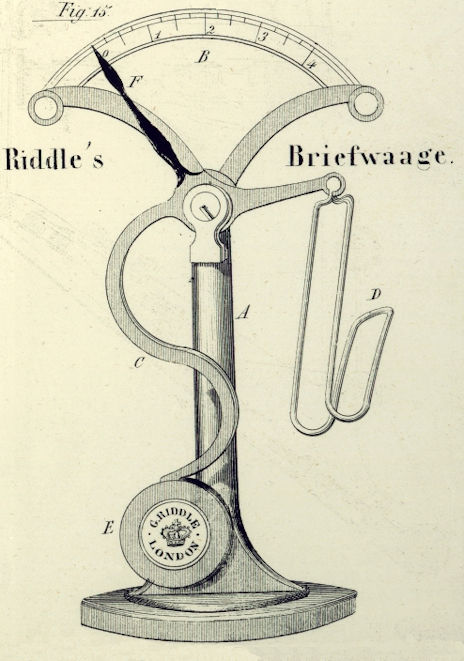 Fig. 4: Riddle's sich selbst justirende Briefwaage [15] |
one and a half columns. Riddle conveniently based his design on the old bent lever balance (fig. 2). It is curious that the weekly magazine mentions three ounces as the weighing range, while the drawing on the cover and the figure of the Registered Design itself show a weighing range of four ounces.
According to the article, at that time only one in a thousand letters was heavier than half an ounce and one in fifty thousand was heavier than an ounce. Converted, this amounts to the following: of every fifty thousand letters, 49,950 are lighter than half an ounce, 49 letters weigh between half and a whole ounce and one letter per fifty thousand letters is heavier than an ounce. The three-ounce range is therefore considered more than sufficient.
Also Riddle's letter scale according to Reg. Design No. 124 is mentioned in the article. And also a combination of his Patent Ever-pointed Pencil with a pocket letter scale suitable for weighing half and a whole ounce. That design is probably not registered and has no Reg. Design number. I know of no example of that combined design from Riddle.
The Inventors' Advocate and Patentees' Recorder also published an image and a favorable review of the letter scale on the same Saturday, December 14, 1839 on page 281 [14] (fig. 3).
A translation of the Mechanics' Magazine article, with an image (fig. 4), appeared even in the German-language periodical Dingler's Polytechnisches Journal [15].
Henry Hooper's letter scales were only described and shown for the first time in Mechanics' Magazine no. 867 of March 21, 1840 on page 456 [16]
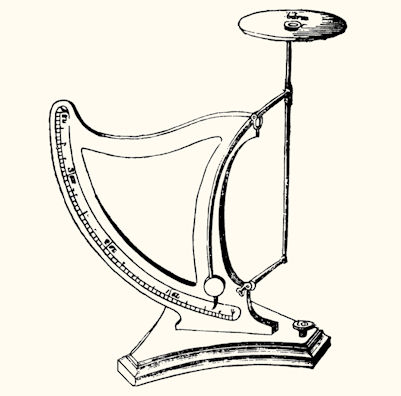 Fig. 5: Quadrant Letter-Balance by George Edwards March 7, 1840 [17] |
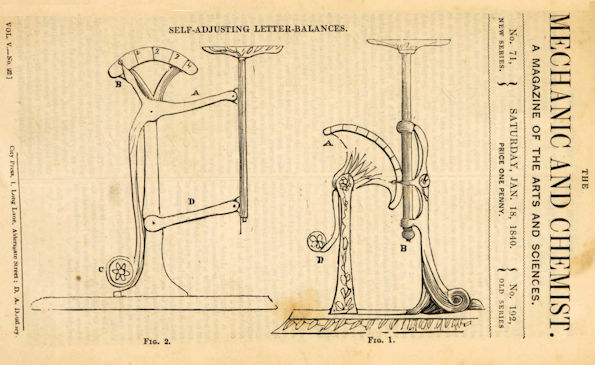 Fig. 6: Self-Adjusting Letter-Balances by J.B. January 18, 1840 [18] |
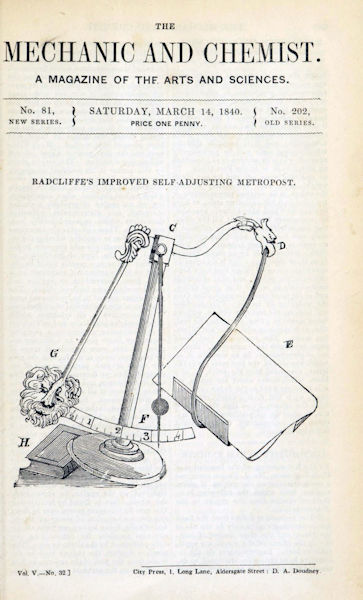 Fig. 7: Radcliffe's Improved Self-Adjusting Metropost March 14, 1840 [19] | There were some nice by-catches while searching for Riddle information. In Mechanics' Magazine No. 865 of March 7, 1840 [17] on pp 420-421 there is a letter dated January 30, 1840 from George Edwards who had ordered a Riddle letter scale from his stationery store after the earlier publication about it in the magazine of December 14, 1839. Because that letter scale still was not delivered, he himself invented a handy letter scale with a parallelogram and an ivory letter plateau, standing on three support points, of which one support point is designed as an adjustment screw. The frame and base are made of mahogany (fig. 5). Apart from the materials used; this is already the design that was widely imitated until the 1970s. |
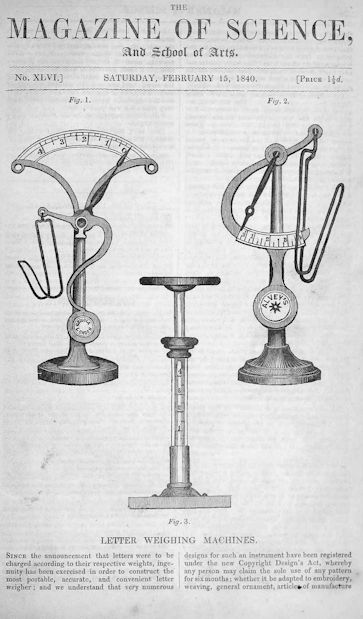 Fig. 8: Oddly partially mirrored Riddle next to Alvey's letter scale underneath a mercury-operated scale February 15, 1840 [22] |
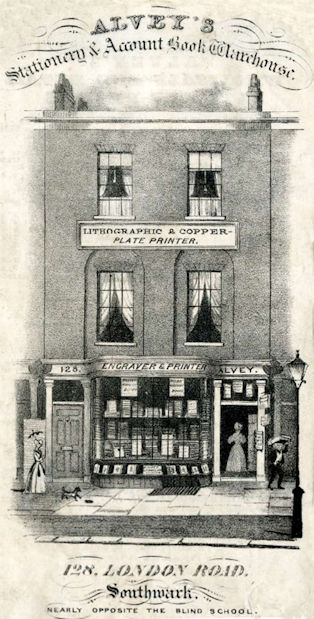 Fig. 9: Trade Card of Alvey's Stationery (image Diana Crawforth-Hitchins) |
The Post Office Directory of 1847 pp 353 [40] lists Frederic Alvey at 128 London Road as a stationer and also as a Post Office Receiving House. A Receiving House was a drop-off point for letters, which were delivered to the main post office six times a day. Receiving Houses were located within 3 miles of the General Post Office. In 1830 Receiving House staff received a fixed annual salary of two pounds, and 1 penny for every ten letters accepted and passed on. No other business was allowed at the address. In 1830 there were 148 Receiving Houses in London City. It is unclear to me how strictly other business activities were checked. |
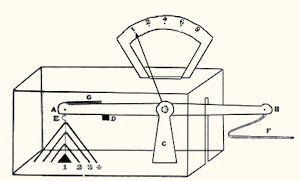 Fig. 10: Conical Letter Weighing Machine by W. Scarfield Gray July 4, 1840 [23]  Fig. 11: Dampier's Patent Geometric-Balance [24] |
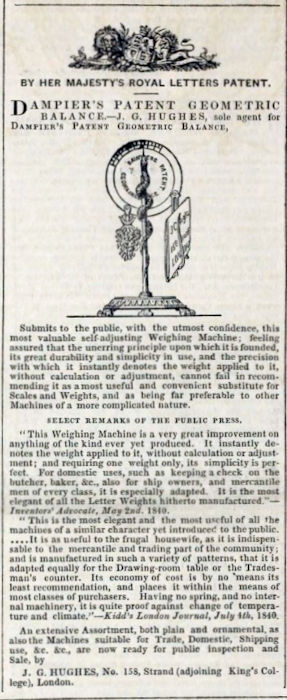 Fig. 12: Advert for Dampier's Geometric Balance by sole agent J.G. Hughes, 158 Strand, London [26] |
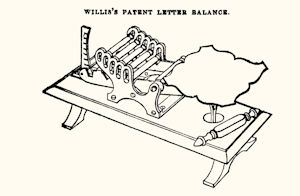 Fig. 13: Willis's Patent Letter Balance [27] 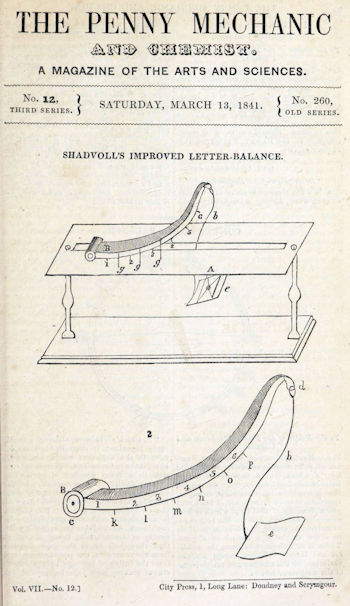 Fig. 14: Shadvoll's improved Letter Balance [28] |
His father Gabriel Riddle (Senior) was born September 29, 1751 and died August 12, 1827. His mother Kezia Duffield was born March 31, 1766 and died July 1856. They were married on December 23, 1784 at Bures near Sudbury. Gabriel Senior worked, among other things, as a baker, later as a surveying General Examiner for Excise, and again later as an excise Officer. There were eight children in this marriage, four sons and four daughters. Their first son is Gabriel Riddle (Junior); born February 7, 1786 in Ipswich, Suffolk (he died in 1863). Then in order; daughter Kezia (born 1787); son William (born 1790); daughter Kezia Miles (born 1792, died 1801 aged 9 years); the twin sons Edward & Robert (born 1795); daughter Ann Eliza (born 1798); and finally daughter Maria (born 1807).
Gabriel Riddle (Junior) married Mary Anne Piper on June 29, 1810 (her parents are Thomas and Elizabeth Piper). Mary Anne Piper died in November 1813, only 27 years old, so she is probably also born in 1786. There is one child born in this marriage: on April 27, 1811, daughter Mary Anne. This child died in 1815, only 4 years old.
Gabriel Riddle (Junior) remarried on May 24, 1819 in All Saints Church in Loughborough, Leicestershire, England to Lucy Staveley (born May 30, 1797, she probably died in December 1870).
There were no fewer than ten children in this marriage (four sons and six daughters); they were all baptized in Anglican churches. In chronological order: daughter Lucy (born 1821, died 1846); daughter Kezia (born 1822, died 1900); daughter Anna Maria (born 1824, died 1887); son George (born 1826, died in May 1838, aged 12 years); son William (born 1828, died 1907); daughter Emily (born 1830, died 1891); son Charles (born 1831, died 1901?); daughter Ella Elizabeth (born 1834, died in 1854, aged 20 years); daughter Alicia (born 1836, died 1907); and finally son Staveley (born 1838, died 1908) [6] and [29].
William Riddle, the second son of Gabriel Junior, was involved in the settlement of his father's bankruptcy, see the short paragraph later in this article.
London at that time had more than hundred livery companies, consisting of trade associations and guilds, and there were still restrictive establishment rules. It's a somewhat complicated system for people living in 2023. For an extensive explanation visit [30]. After starting as an apprentice one could be made free in several ways: by servitude, by patrimony, by redemption, and also by courtesy. Gabriel Riddle was made free in the guild Stationers' Company, it was by Patrimony on October 6, 1818 [31], or was it by Redemption [32] in 1822? It is not really unambiguously clear. In any case he has been accepted into the guild.
 Fig. 15: The Westminster Tobacco Box (taken from [33]) | Gabriel Riddle was probably an Overseer of the St. John the Evangelist Church in the period 1818 - 1819 [33]. (I asked the Past Overseers' Society to make sure it's Gabriel Riddle Junior and not Gabriel Riddle Senior. I received no answer until now). Overseers of the Poor were active in collecting mainly money for the poor in their own parish. Since the Poor Law Act of 1601 it became a tax compulsory on all householders. An Overseer was appointed per year and was not paid for his activities. In Westminster London, overseers were selected by the Justices of the Peace, in the parish of St Margaret's two persons and in the parish of St. John the Evangelist one person per year. |
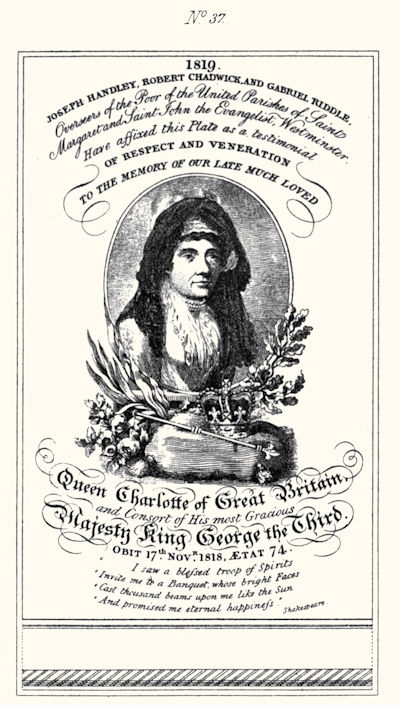 Fig. 16: The name Gabriel Riddle top right engraved on a silver plate (taken from [33]) | In December 1837, a fire destroyed his home at 172 Blackfriars Road, but the adjacent factory was spared, Riddle stated this in an advertisement to reassure his customers (fig. 17). 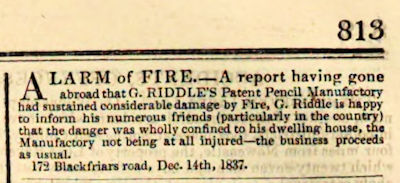 Fig. 17 Advertisement by Riddle to reassure his customers in December 1837. A fire destroyed his home at 172 Blackfriars Road, but the adjacent factory was spared. (in The Examiner 1837-1838, pp 813) In the October 1817 List of Governors and Officers of the Asylum for the support of the Deaf and Dumb Children of the Poor established in London in 1792, pp 151 [38], and also in the May 1821 List of the same, pp 154 [39], Gabriel Riddle Jun. Esq. Excise-Office is listed as Lifetime Governor, which means that he made a donation of 10 Guineas or more to the Asylum and thus obtained a voting right. In January 1838 Gabriel Riddle became chairman of the Asylum for Deaf and Dumb. In 1861 Gabriel Riddle retired from business and moved to Brighton.Gabriel Riddle died in December 1863 at the age of 77. Riddle's AddressesRiddle as a baker at 17 Abingdon St, London (1803, also 1822);Riddle as a coal merchant at 1 Millbank St, London (1811); Riddle as coal merchant at 17 Abingdon St, London (1820 also 1823); Riddle as a Wholesale Fancy Stationer, selling Mordan pens to the Trade at 25 Paternoster Row in London. It's a street of publishers, booksellers and stationers. (Nov 1822 - until auctioned in 1847); Riddle enters into partnership with Mordan at 22 Castle Street, Finsbury, London (agreement 1823-1836); Riddle at 172 Blackfriars Road (1836 - until auctioned in 1848); Riddle as a retiree, at 16 Charlotte St, Brighton |
Riddle ProductsThis summary is certainly not complete; in several images more products are listed.It gives an impression. - patent wrought iron wheels in cooperation with Piper and Jones; - patent ever-pointed pencil; - universal penholder; - coronet & diadem fountain inkstand (fig. 18); - duplex fountain inkstand - a combined inkstand for black and red ink; - lead points; - pure Cumberland lead writing and drawing pencils; - penholders; - quill and steel pens; - revolving top fountain & duplex inkstands; - self-adjusting letter balances; - money balances; - patent hemispherical stoppered bottles; scents, &c; - patent five and seven-guarded locks &c of the Bramah and Barron patent principle; - iron safes; - fire-proof boxes; - Lareviere's patent perforated address cards sold by Riddle & Co (March 1834) and by Riddle & Meymott stationers (December 1834 and January 1837); - trouser straps (October 1846). In the Post Office London Directory of 1847, pp 942, Gabriel Riddle is still listed as a mechanist & manufacturer of patent ever pointed pencils & leads, & various other patented & registered articles, at 172 Blackfriars Road [40]. |
 Fig. 18: Victorian silver gilt mounted marquess coronet on a green glass 'tea kettle' syphon inkwell made by Gabriel Riddle, London 1838 (Courtesy of David W.A. Buck / Steppes Hill Farm Antiques, Sittingbourne, Kent, England) (collage by Sol) |
Riddle & Piper & JonesThomas Piper, Gabriel Riddle and Theodore Jones were partners in the firm Patent Wrought Iron Wheels Manufacturers, under the name Theodore Jones & Co. I have not found when this firm started. On February 14, 1839, the partnership with Jones was dissolved and all debts and obligations were paid and settled by Piper and Riddle [42]. Together with Thomas Piper (his former father-in-law? or his brother-in-law?), Gabriel Riddle holds patent No. 5415 from 1826 on wrought iron carriage wheels purchased from original inventor Theodore Jones. That patent had a term of 14 years. A request to extend the term of the patent "A certain improvement or improvements on wheels for carriages" by 7 years was submitted in April 1840 and granted on October 22, 1840 under No. 8667, (fig. 19). The firm as Theodore Jones and Co. Patent Iron Wheel Manufacturers was dissolved by mutual consent on December 25, 1843. All the debts, liabilities and engagements of the said co-partnership will be paid and performed, and all the debts owing to the same will be received by Thomas Piper, this was agreed on April 21, 1845 [43]. |
 Fig. 19: A grant unto Gabriel Riddle and Thomas Piper of an invention for "A certain improvement or improvements on wheels for carriages" by 7 years to be computed from 11th October instant. Granted on October 22, 1840 under No. 8667 (in Titles of patents of inventions, chronologically arranged by Bennet Woodcroft 1854, pp 1125) |
Sampson Mordan (born 1790) was an excellent student and later assistant of the mechanic John Bramah (1748-1814), an inventor of patented locks. In 1815 Mordan started his own company.
The first patent for a metal mechanical refillable pencil with lead-propelling mechanism - better known as the ever-pointed pencil - was issued to Sampson Mordan and John Isaac Hawkins in Great Britain, and published on 20 December 1822 as British Patent No. 4742 [44], [45], [46]. John Isaac Hawkins (1772-1855) was an English mechanical engineer, entrepreneur, inventor and patent agent - a very creative personality of his time [47]. After buying out Hawkins' patent rights, Mordan entered as small-worker his first brand SM on 9 June 1823 [48]. Mordan had big plans but not enough money.
A year later, he entered into a partnership with affluent stationer Gabriel Riddle, who was living and working as stationer at 25 Paternoster Row, London.
According to Kenneth Bull [49], Mordan purchased the sole right to Hawkins' patent in 1823 for £450, payable in instalments. Immediately afterwards, Mordan sold half of the right to the possible profit to the wealthy stationer Gabriel Riddle, Mordan needed the money to further exploit the patent and for that purpose it was necessary to expand the company.
Gabriel Riddle is believed to have borrowed money from his wealthy farming in-laws, Staveley, to enable Mordan to purchase the patent rights to the propelling pencil from Hawkins for £400, conditional on his participation in Mordan's company. In Christopher Staveley's will dated 12 November 1819 [50] is stated that his daughter Lucy (that is the wife of Gabriel Riddle) has already received an advance of £300 on her inheritance. Perhaps as a wedding gift?
In 1861 William Riddle, a son of Gabriel Riddle, wrote in a letter to "The Builder" [51] that the company S. Mordan & Co was founded with his father's money.

On April 30, 1824, Mordan and Riddle received as plate workers the silver hallmark SM·GR, (the initials of Sampson Mordan and Gabriel Riddle) [48]. In Grimwade [52] at page 284 incorrectly listed as SM·GB (fig. 20). The Mordan pencil was then sold under the SM·GR brand. The company address was 22 Castle Street, Finsbury in London. They manufactured their Ever-pointed pencils in an extensive range, in silver and gold. And other writing and stationery articles, and for instance also Bramah locks. In 1833 they employed 50 workers in the production of ever-pointed pencils in their workshops. The partnership between Mordan and Riddle lasted from 1823 through 1836.
There were several cases of theft at Mordan & Riddle, according to reports from Old Bailey trials. For example, in 1825 an eighteen year old worker was sentenced to two months in prison for stealing 2 ounces of silver. In 1826, a fifteen-year-old errand boy from the firm of Mordan & Riddle was sentenced to transportation (to Australia?) for 14 years for the theft of nine silver pencil boxes and 9 ever-pointed pencils with a total value of over £22.
End of Collaboration between Mordan & RiddleAccording to a communication from Gabriel Riddle dated January 16, 1837 made in an advertisement in The London Gazette of January 17, 1837 on pp126, the agreement between Riddle and Mordan concluded in October 1823 was terminated on December 20, 1836 [53] (fig. 21). |
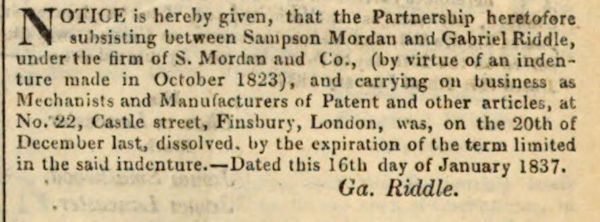 Fig. 21: Announcement made by Riddle declaring that the partnership between Riddle and Mordan was terminated [53]  Fig. 22: Riddle thanking his friends and the general public for the encouragement the firm received (in magazine The British Critic, quarterly theological review and ecclesiastical record, Vol. XLII, April 1837, pp 8) |
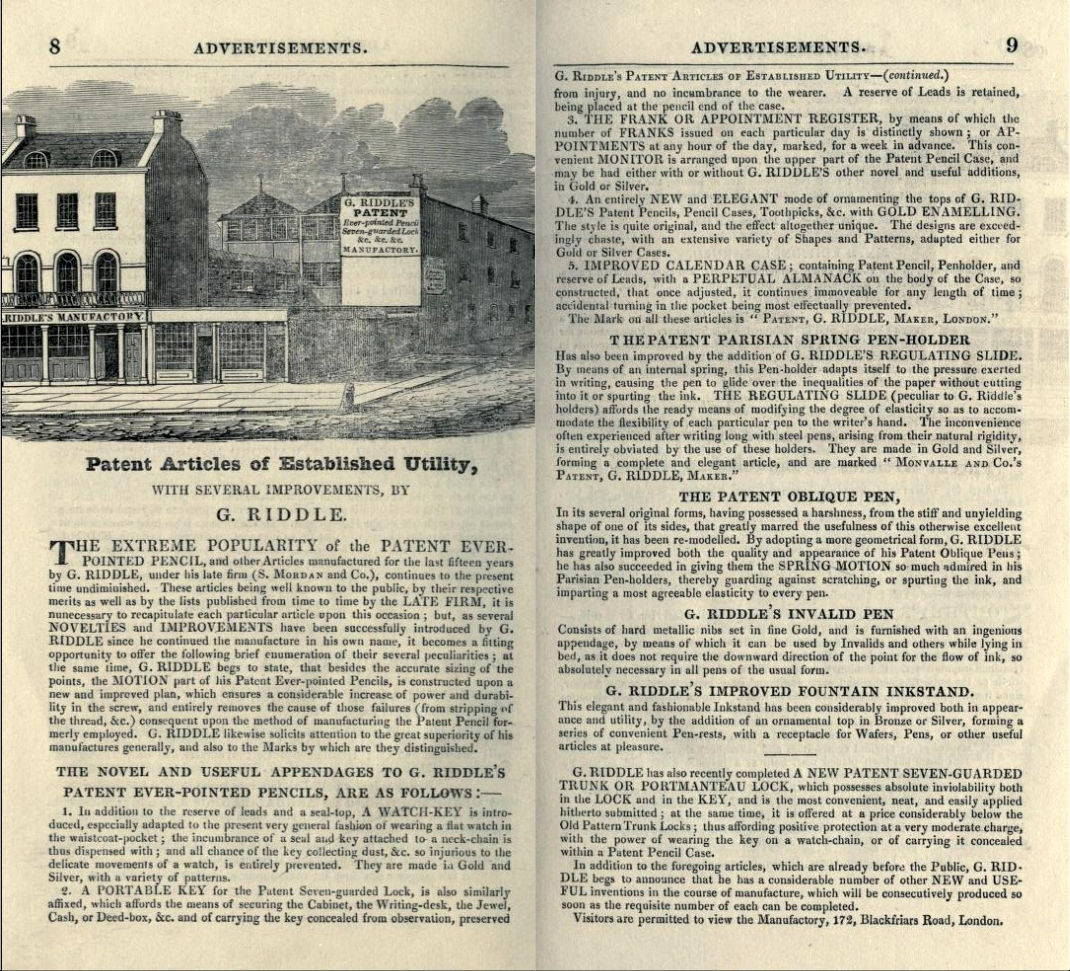
Until the end of December 1836, Gabriel Riddle has been active as stationer at 25, Paternoster Row, now he started the production of Patent & Other Items again on his own at the new address 172 Blackfriars Road (fig. 23) under the company name G. RIDDLE. This lasted until the unexpected forced sales of his businesses and assets in 1847. It is striking that both gentlemen apparently retained ownership rights to the products produced until then after the termination of their agreement. Looking back, Mordan was much more inventive and creative in developing and producing new products compared to Riddle. Mordan was also better from a business perspective.

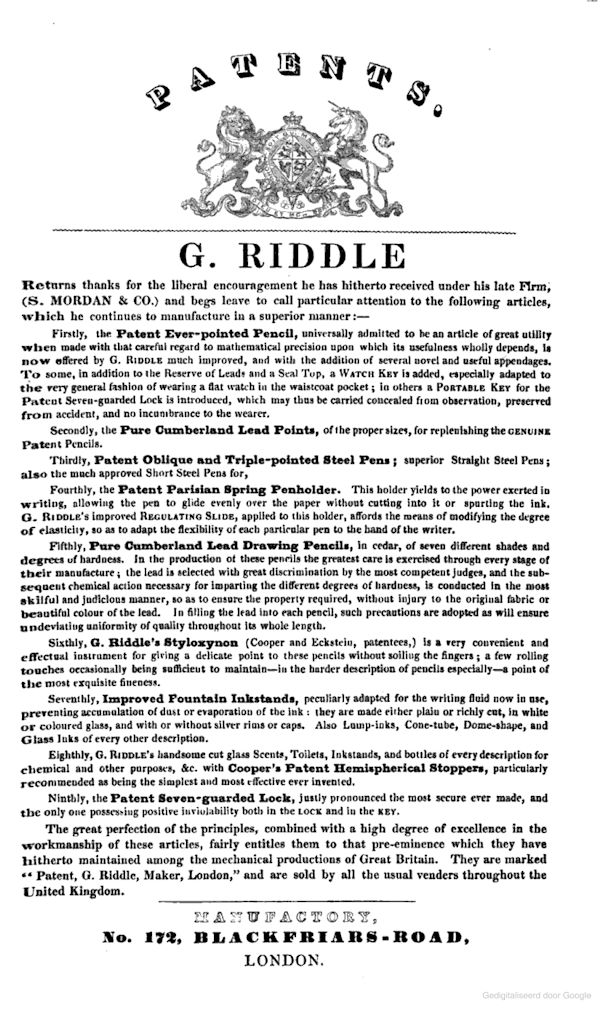 Fig. 25: Riddle thanks for the support received and advertises nine products under his own company name ([54] |
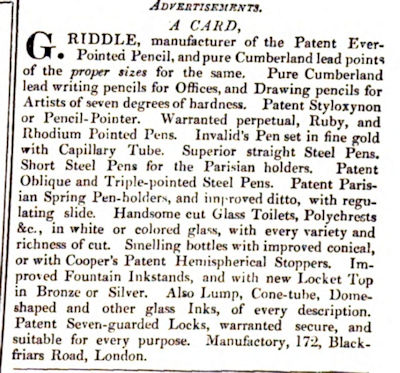 Fig. 26 Advertisement with a summary of Riddle products [55]  Fig. 27: Riddle's spirally-propelled Patent Ever-pointed Pencils, with press reviews, and his pure Cumberland lead points [58] |
They are listed as such at 25 Paternoster Row, in London Robson's Street Directory in 1832, and the same in London Robson's Street Directory 1842 [59]. It remains unknown to me who this Barfoot is; the activity mentioned they are ink-makers for writing. Note: the name Meymot is with one t. Maybe a printing error?
This William Meymott started in April 1812 as a new apprentice with Master Joseph Barfoot, a Co Stationer. Meymott's father paid a bond value of £157.10s for this. In May 1819 William Meymott became a new freeman by servitude and got the status of Co Stationer.
Presumably Riddle had looked for a new partner with money to continue producing the writing and office supplies after the end of the period with Mordan. Meymott became this new partner. The concluded contract later turned out to lead to the inevitable demise of Riddle's company.
They sell Lariviere's patent perforated lace address cards (according to adverts already in December 1834, and also January 1837).
As of 1836 there is an official contract with William Meymott (this according to Meymott's will from 1842).
As of May 14, 1838, Riddle & Meymott were insured as booksellers & merchants.
Riddle & Meymott sell Plowman's portable letter copier (Advert May 2, 1840) [60].
In September 1842 Meymott made his will. He is then 44 years old.
1842 Riddle & Meymott are mentioned as stationers [59].
1845 Riddle & Meymott are mentioned as wholesale stationers.
William Meymott died in August 1846.
In September 1846, Meymott's share in the company Riddle & Meymott was determined and sold in accordance with the will, and in accordance with the contract of 1836. Immediately £200 must be paid to his widow Theresa Sarah Meymott. This was dramatic, also for Riddle and his company.
This sudden need to make a lot of money available put Riddle's company in serious financial trouble. Gabriel Riddle was forced to sell his assets step by step.
William Leschallas & Alfred Rodriques, Wholesale Stationers, were instructed by Gabriel Riddle, of 25 Paternoster Row, by contract on 16 January 1847, to act in favor of the creditors of the firm of Riddle & Meymott. Riddle granted and assigned all his estates and effects, both real and personal to them. This was confirmed recorded in a deed of assignment by the solicitor of the trustees, January 18, 1847 [61] (fig. 28).
In February 1847, Riddle & Meymott's stock was auctioned on behalf of the trustees, among others the iron rolling mills for making morocco paper and decorative gold borders, a lot of pens and pencils, inks, reams of paper, papier maché articles, locks, &c., see the auction advert [62] (fig. 29).
25 Paternoster Row was also auctioned with immediate delivery, a dwelling house with the shop with two windows and the business premises used by Riddle & Meymott.
In October 1847, Gabriel Riddle gave on trust to Thomas Piper the younger (his former brother-in-law) and William Riddle of the Excise Office all of Gabriel Riddle's stock, tools, implements of trade, fixtures, machinery, debts, accounts, money and personal effects for the benefit of his creditors [63] (fig. 30).
 Fig. 28: Confirmation Riddle granted and assigned all property, real and personal, to two curators, in favor of the creditors of the firm of Riddle & Meymott, recorded in a deed of assignment [61] |
 Fig. 29 Sale by auction of the stock of Riddle & Meymott, by order of the trustees on March 1-3, 1847 [62] |
 Fig. 30: Notice Gabriel Riddle by indenture did grant and assign unto Thomas Piper and William Riddle all stock &c, personal belongings, &c - see the summary above - for the benefit of the creditors of Gabriel Riddle [63] |
In The Post Office London Directory of 1847, Riddle & Meymott are still listed as wholesale stationers at page 428 [40].
In February 1848, on behalf of the trustees, an auction was announced on 15 March 1848 of the factory and house and what remained at the address 172 Blackfriars Road [64]. This concerns the unexpired right of use for a period of ten years at a reasonable rental price. The buyer is given the opportunity to take over the machines and installations upon appraisal (fig. 31).
An auction of Gabriel Riddle's trading stock was also announced on the instructions of the trustees on the same day March 15, 1848 and the two following days [64]. This consisted of 2,500 gold and silver ever-pointed pencils, boxes with writing lead markers, 100 gold and silver snuff boxes, 140 wax stamps with beautiful patterns, 400 silver patent pen holders inlaid with silver and gold, 80,000 portable quill pens, approximately 2,000 glass fragrance and perfume bottles, in a wide variety of pattern and colour, some with silver and gold rim and cap. 1000 glass inkstands, gold and silver toothpicks, letter and coin balances, 600 gross steel pens, 250 gross cedar pencils, and a wide variety of other articles (fig. 32). Unfortunately, the number of letter balances and coin balances is lacking.
In May 1848, the curators auctioned the stock of all kinds of locks, including Bramah locks.
On June 9, 1848 a second portion of the genuine stock in trade was put into auction, again are letter and coin balances listed. [65] (fig. 33)
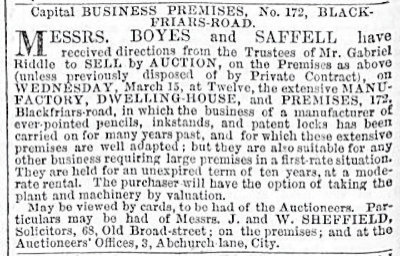 Fig. 31: Announcement of auction on 15 March 1848 of the factory and house and what remained at the address 172 Blackfriars Road [64] |
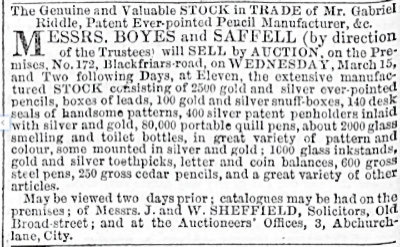 Fig. 32: Announcement of auction to be held on 15 March 1848 of the manufactured stock and a great variety of other articles, including an unspecified number of letter and coin balances [64] |
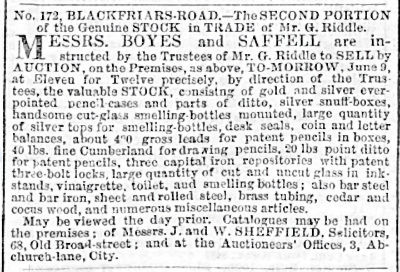 Fig. 33: Announcement of auction to be held on June 9, 1848 of the second portion of the genuine stock in trade of Mr. G. Riddle [65] |
On June 19, 1848 there was an auction of Riddle's machinery and tools for the production of locks, the patent ever-pointed pencils, pencils and cedar pencils, also a large stock of locks and the like, key-cutting machine, machine for cutting the casings of locks, eleven iron screw press, lathes, a motor-driven lathe with an 11 inch long bed, 18 lathes ranging from 3-6 inches, rolling machine, 2 lathes with rose motor and chucks (see Wikipedia for explanation), damasking machine, 2 sawing machines for metal pipes, 2 tensile benches, rounding machine for cedar pencils, large flywheel with friction rollers, cartridges for flywheels, glass cutting and polishing benches, and common tools and apparatus for each department, &c. &c. [66] (fig. 34). |
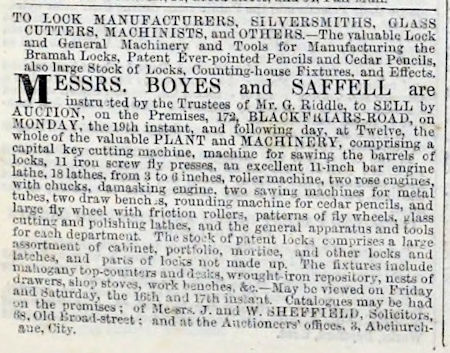 Fig. 34: Announcement of auction to be held on June 19, 1848 of G. Riddle's lock and general machinery and tools &c, at the address 172 Blackfriars Road [66] |
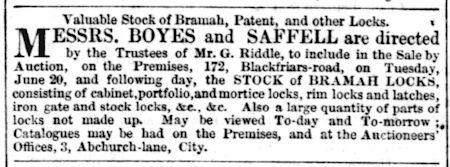 Fig. 35: Announcement of auction on June 20 and 21, 1848 of the stock of all kinds of locks, including Bramah locks [67] |
William Riddle, Gabriel's second son, has several patents to his name. On December 21, 1848 he obtained a rather striking patent with GB12383 on "Improvements in the construction of ever-pointed pencils, writing and drawing instruments, and in inkstands or inkholders" [68]. He was probably helped by his father. According to [49] William did not exploit the patent himself; he quickly transferred the patent rights to William Lund.
William obtained a patent for a hay bale tying machine in 1858. In 1869 he also obtained an American patent US93555 with the title "Packing-Device" for tying cotton bales. In 1862 a patent on a hydraulic or otherwise working pressing machine for cotton and other fibers. In 1864 a patent was issued for making buildings and other structures more fire-safe.
William Riddle also has several Registered Designs to his name. In 1848 Reg. Des. No. 1427 Folio clip; in 1848 Reg. Des. No. 1435; Label damper; in 1848 Reg. Des. No. 1436 Foot Bath; in 1849 Reg. Des. No. 1749 "Porte Flacon" or Wine; in 1849 Reg. Des. No. 1766 for a gas burner with built-in igniter; in 1850 Reg. Des. No. 2554 Latch and Bolt Union; in 1851 Reg. Des. No. 90 Hat Peg.
At the Great Exhibition of 1851 in London, William Riddle presents a steam fire extinguisher for steamships. Apparently William Riddle was inventive and certainly enterprising.
There are very few Riddle letter scales to be found. I only saw different examples of this No. 113 letter scale design. There are versions in three weighing ranges: two, three and four ounces. An advertisement in the Derby Mercury of May 20, 1840 [69] states: |
 Fig. 36: Advertisement for G. Riddle's self-adjusting letter balances of three sizes, viz., to weigh from a quarter of an ounce up to 2 ounces, to 4 ounces or to 16 ounces!! [69] |
 Fig. 37: Drawing of Riddle's Registered Design No. 113 of November 28, 1839, 4 ounces by ¼ oz. capacity, unit of measure not indicated (image Diana Crawforth-Hitchins) |
 Fig. 38: Letter Scale No. 113 in black with silver plated arc 4 ounces by ¼ oz. capacity, unit of measure not indicated (private collection) |
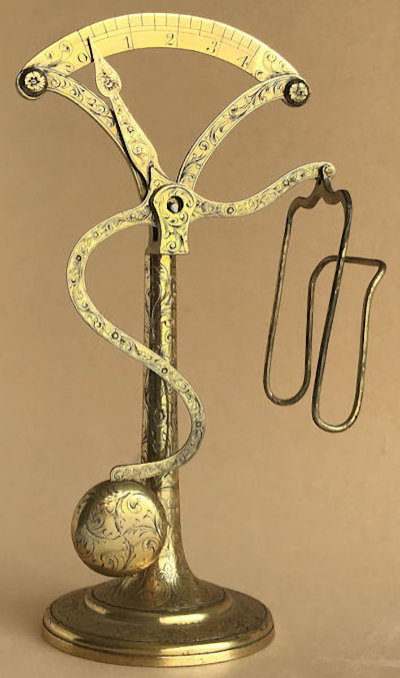 Fig. 39: Letter Scale No. 113, fully gilded and engraved florally, Reg. Des. No. and date not engraved, also no crown and no G. Riddle London text on the counterweight, 4 ounces by ¼ oz. capacity, unit of measure not indicated (private collection) |
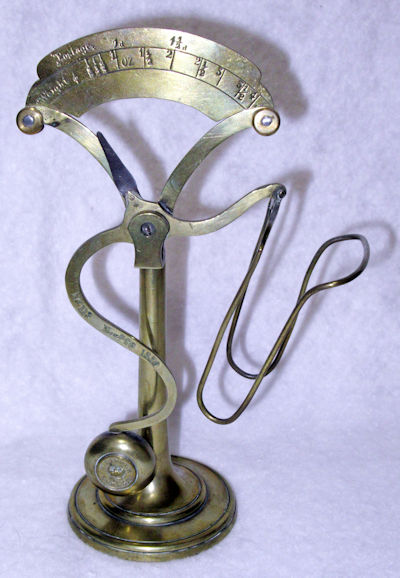 Fig. 40: Letter Scale No. 113 in shiny brass with different size scale (collection Carol Hayden) The measuring scales are subdivided per quarter ounce. The scale of Hayden's Riddle deviates from this. In addition to stripes per ½ oz, this also has a stripe for ⅓ oz and for ⅔ oz. |
 Fig. 41: The different size scale, 4 ounces by ½ oz. capacity and extra stripes for ⅓ oz. and ⅔ oz. the unit of measure is indicated, as well as the postal rate in pence (collection Carol Hayden) 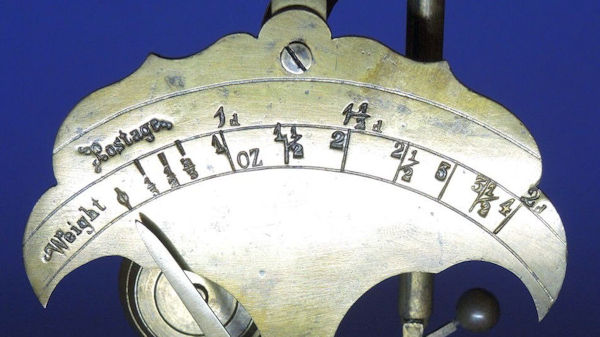 Fig. 42: This size scale of a letter scale made by Marion & Co looks very much like the size scale shown above in fig. 41 (image taken from the internet) |
There is a crown on the front surface of most the counterweights. Above it the name G. RIDDLE and below it the place name LONDON (fig. 44). The curved counterweight arm bears the Registered Design Number 113 and the date abbreviation Nov.r 28 1839 which was issued to Gabriel Riddle of London (fig. 45).
The gold-plated version is extensively decorated with flowers and leaves and therefore has no crown and texts on the counterweight. There is also no text on the curved counterweight arm. The blackened copy does have the text clearly legible in white on the counterweight arm.
The four ounce model is 190 millimeters high, the base diameter is 72 mm, the scale width is 95 mm, and the counterweight diameter is 28 mm. The Riddle scale of Carol Hayden is 203 mm high due to the different scale.
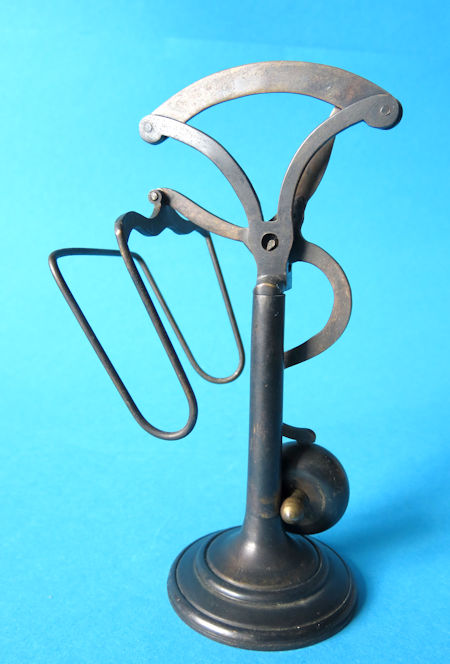 Fig. 43: The small protrusion centrally on the back of the counterweight acts as a stop button (Sol collection) |
 Fig. 44: A crown on the front surface of several of the counterweights. Above it the name G. RIDDLE and below it the place name LONDON (Courtesy of Tennants Auctioneers, North Yorkshire, England) | 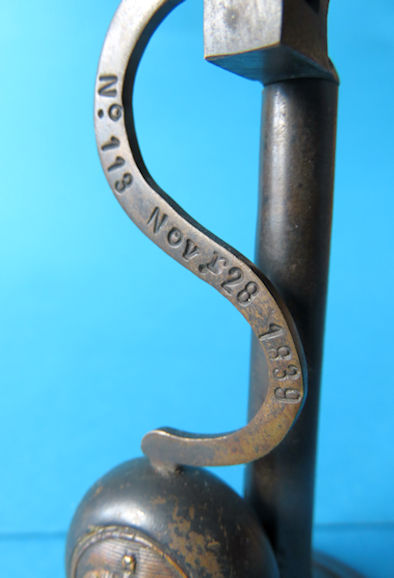 Fig. 45: The curved counterweight arm has the Registered Design Number 113 and the date abbreviation Nov.R 28 1839 (Sol collection) |
The Riddle with a three-ounce range (fig. 46) is owned by Gregg Motter. So a Riddle letter scale with a weighing range of three ounces appears to exist after all! The measuring scale of this brass letter scale was once silver-plated; traces of this can still just be seen. The dimensions of this scale are the same as the 4oz ones from a private collection. |
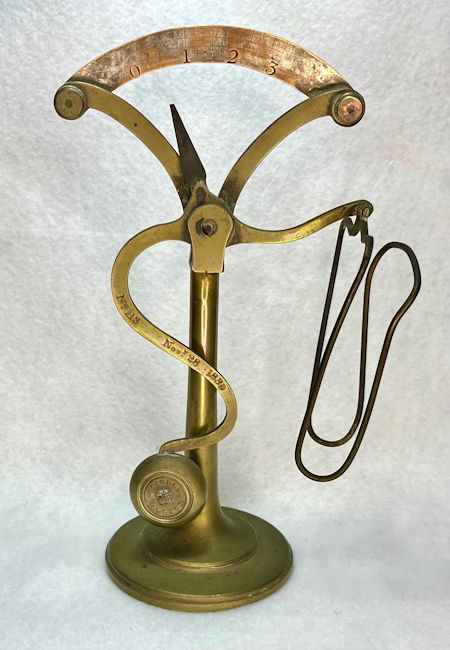 Fig. 46: Riddle letter scale No. 113 with a capacity of three ounces (collection Gregg Motter) |
 Fig. 47: Riddle letter scale No. 113 with a capacity of two ounces (Sol collection) |
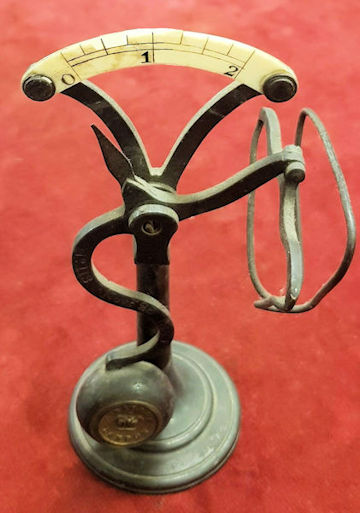 Fig. 48: Riddle letter scale No. 113, ivory scale with a capacity of two ounces (image taken from the internet) |
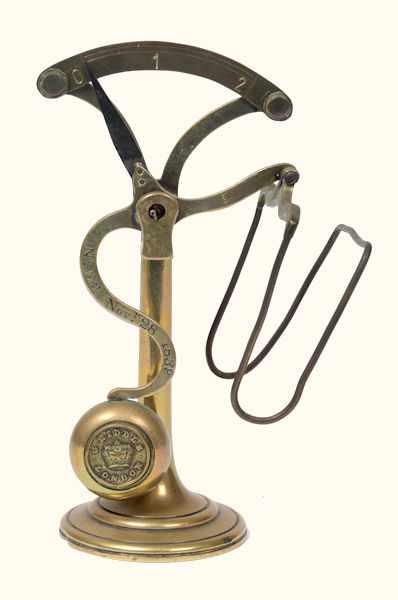 Fig. 49: G. Riddle Pendulum Letter Balance No. 113, entirely of shiny brass, range two ounces (Courtesy of Tennants Auctioneers, North Yorkshire, England) |
The two ounce Riddle can be seen in three different versions, see (fig. 47 - Sol), (fig. 48 - ivory) and (fig. 49 - Tennants). The letter scale is made of dark patinated brass and has an ivory or dark patinated measuring scale, or the letter scale is made entirely of shiny brass. The two ounces model is 129 millimeters high, the base diameter is 49 mm, the scale width is 63 mm, and the counterweight diameter is 26 mm. the Sol copy only has a crown on the front surface of the counterweight on a horizontally striped background. The model of this crown is different from the crowns on the other scales. The texts G. RIDDLE and LONDON are missing on the SOL copy (fig. 50). Perhaps this copy was made by someone else with parts from the sold bankrupt estate? It remains a guess. Several scale parts are connected to each other with threads (fig. 51).
 Fig. 50: This counterweight has a different crown and not the name G. RIDDLE and the place name LONDON (Sol collection) |
 Fig. 51: This Riddle letter scale has several parts that are connected to each other with screw thread (Sol collection) |
The pointers are a striking part. Both scales from a private collection have a pointer similar to that on the Registered Design drawing. The Gregg Motter, Carol Hayden's scale and the ivory scale version all have a curiously too short pointer. The Riddle letter scale of Tennants has a pointer with a simple shape and a correct length. The pointer on Sol's copy has the same simple shape but is a fraction too long.
The bottoms of the scale foot differ, from rough cast brass surface to smooth turned on a lathe. All outer edges are smooth. There are dot markings on the bottom edge of the black scale of the private collection. The Gregg Motter scale has the letter M and also XX as markings on the bottom edge. The gilded Riddle, the Riddle of Carol Hayden, and the Riddle of Sol have no bottom markings. The upright forms a whole with the scale foot at the scales of the private collection, of Hayden and of Motter. The exception is the Riddle scale of Sol, which has a threaded connection between the scale foot and upright.
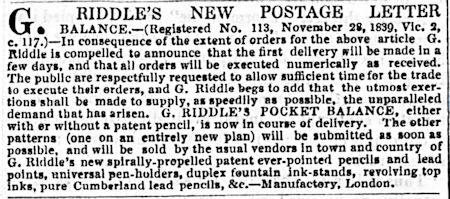 Fig. 52: G. Riddle announces that the first delivery will be made in a few days advert of December 11, 1839 [70] |
 Fig. 53 Advertisement announcing Mordan's and Hooper's letter balances are available in December 1839 [71] |
 Fig. 54: G. Riddle's self-adjusting letter balance "for accuracy and distinctness of indication, the best letter balance hitherto produced," [72] |
An Advert in The Morning Herald of December 11, 1839 [70] announces "that the first delivery will be made in a few days, and that all orders will be executed numerically as received. The public are respectfully requested to allow sufficient time for the trade to execute their orders, and G. Riddle begs to add that the utmost exertions shall be made to supply, as speedily as possible, the unparalleled demand that has arisen." (fig. 52). This seems to be an announcement that the actual delivery will not happen for the time being. According to an advertisement in The Suffolk Chronicle of December 14, 1839 [71], Mordan and Hooper letter balances were already available (fig. 53). An Advert in British Books of January 1840 [72] announces: New Postage. G. Riddle's self-adjusting letter balance registered (No. 113)….."for accuracy and distinctness of indication, the best letter balance hitherto produced," may now be had at the usual venders, in town and country, of G. Riddle's Patent Ever-Pointed Pencils, &c. &c. (fig. 54).
According to an advertisement in The Leeds Times of March 7, 1840 [73], the Riddle letter scale can now be purchased - Finally! - at stationers and bookshops for 14s and 6d (fig. 55). Perhaps this was the price for the luxurious gold-plated version? For comparison: the cheapest Hooper according to Registered Design No. 1 with a simple steel letter clamp costs 3 shillings and 6d, the most expensive version on a stand with a hinged leaf spring letter clamp costs 10 shillings and 6d. The simpler letter scale from Hooper according to Registered Design No. 68 costs 1 shilling and 9d, a more luxurious version with the easier to operate hinged letter clip costs 2 shillings and 6d [7] and [74]. The sale of this Riddle letter scale started sometime in March 1840. An advertisement, in which Mordan, Riddle and Hooper letter balances are offered at prices ranging from 2s to 21s each, appeared in the Lincoln Chronicle of March 13, 1840 (fig. 56) [75]. I did not find any other advertisement in which the letter scale or letter balance appears. |
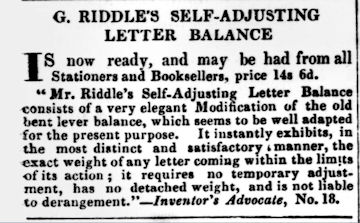 Fig. 55: Advertisement March 7, 1840, the Riddle letter scale could now be purchased at stationers and bookshops for 14s and 6d [73] |
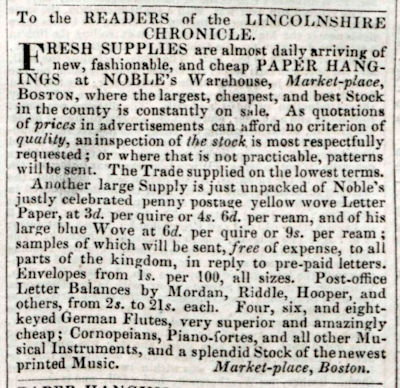 Fig. 56: Advertisement in which Mordan, Riddle, and Hooper letter balances are offered at prices ranging from 2s to 21s each [75] |
Riddle as a manufacturer of letter scales, was last mentioned in the London Street Directory of 1843. The announcement of the auction sale of the stock at 172, Blackfriars Road in February 1848 mentions the letter scales and coin scales. The advertisement does not tell how many copies are still in stock.
The level of the sales price found probably partly explains why Riddle letter scales are even significantly rarer than Hooper letter scales. The small number of advertisements for the Riddle letter scale may be another cause for its rarity. The fact that Hooper and Mordan were able to deliver months earlier did not help either. The short production period, from 1840 to probably 1843, also contributes to the rarity.
This is a beautiful design for a letter scale (fig. 57). At the top of a fixed round stand is a calyx with a wing part of a bird attached to it. The measuring scale is attached between the wing end and the center of the upright. The moving part of the letter scale consists of the neck and head of a griffin, a mythical bird. The pointer arm with the counterweight is attached to this. The arm with the counterweight moves behind the scale. The pointer arrow is connected to the pointer arm with a snakeskin-like part and moves in front of the scale. The griffin has a two-headed snake in its mouth; this part is the letter holder. The counterweight has a crown and · G. RIDDLE · LONDON around it. The size scale again shows the name G.RIDDLE and the number 121 plus the date Dec.r 6, 1839 of the Registered Design. The three ounce measuring scale is subdivided by ¼ ounce. Unfortunately, this letter scale was probably never made. |
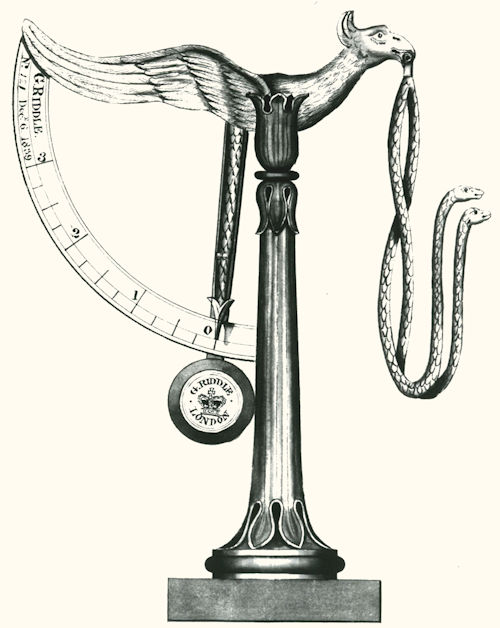 Fig. 57: The G. Riddle letter scale according to Registered Design No. 121 of December 6, 1839, capacity three ounces, subdivided by ¼ ounce (image Diana Crawforth-Hitchins) |
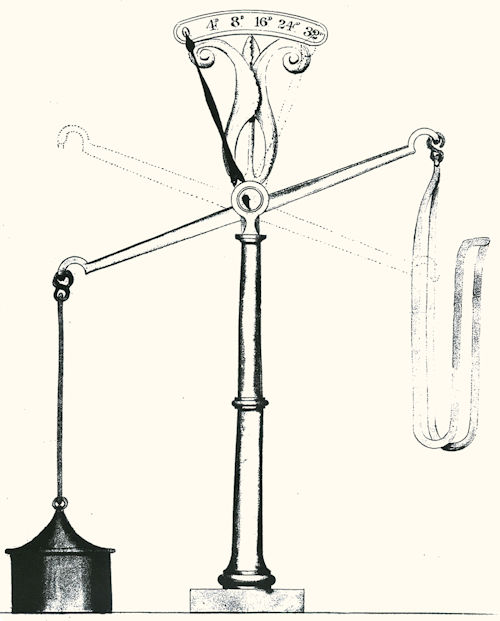 Fig. 58: The G. Riddle letter scale according to Registered Design No. 124 of December 10, 1839, in unloaded position. Scale values are 0, 4D, 8D, 16D, 24D and 32D, for the letter weights of 0, ½oz, 1oz, 2oz, 3oz and 4oz. (image Diana Crawforth-Hitchins) |
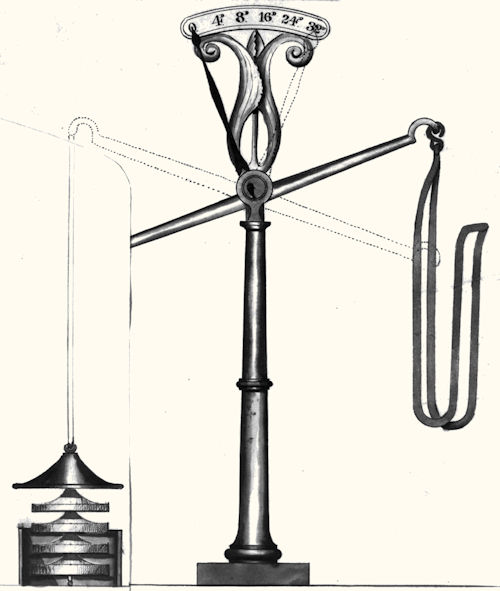 Fig. 59 The G. Riddle letter scale according to Registered Design No. 124 of December 10, 1839 in loaded position. On the left the conical weights are lifted out of the cylindrical shaped container. (image Diana Crawforth-Hitchins) |
This is an equal-arm balance with an arc on top of the upright on which a measuring scale is located, (fig. 58 and fig. 59). The scale values are 0, 4D, 8D, 16D, 24D and 32D. This is the letter post rate just before the Penny Post in the short period from December 5, 1839 to January 10, 1840 for the letter post weights 0, ½oz, 1oz, 2oz, 3oz and 4oz. On the right, a letter holder hangs hinged on the balance arm. On the left is a set of conical weights in a cylindrical shaped container. As the letter weight increases, more of those cone-shaped weights are lifted by the wire with which they are connected and which is connected to the balance arm on the left. The user immediately reads the required postal rate on the scale. This letter scale was probably never produced either.
 Fig. 60: The G. Riddle coin scale according to Registered Design No. 1312 of June 17, 1842. An equal-arm balance with a slide. For testing a Sovereign, the entire storage tube serves as a counterweight; the storage tube without the cap is used for testing a half sovereign. (image Diana Crawforth-Hitchins) |
This is a foldable coin scale that fits in a tube to carry in a vest or trouser pocket (fig. 60). It is an equal-arm balance with a slide on the right and a scale from 1 to 6, in which unit it is not clear, probably in grains (1gr = 0.065 grams). When testing a Sovereign, the entire storage tube serves as a counterweight; the tube without the cap is used when testing a half sovereign. A sovereign weighs 7.98805 grams. I have seen only one example of Riddle, it was sold at Skinner Auctions in 2003 [76]. |
 Fig. 61: Letter scale without a slider by Mordan & Co. With the cap attached on the hook good for ¼oz. With the cap and tube together good for ½oz. These values are engraved in the tube parts. (collage by Sol of photos from the internet) |
 Fig. 62: The Riddle coin scale according to Registered Design No. 1313 of June 17, 1842 according to Sheppard & Musham [77], with a size scale for half and a size scale for a whole sovereign. (image Diana Crawforth-Hitchins) |
This is a pendulum coin scale on a tripod. According to the illustration in Sheppard & Musham [77] (fig. 62), the ivory measuring scale is divided per half grain, a total of six grains. There is a holder for the counterweights on the left side of the scale arm. The sovereign or half-sovereign coin to be checked for weight is placed on the scale hanging from the right scale arm. In the Registered Design image, the size scale is divided into six steps from 20 to 19 for the whole sovereign, respectively from 10 to 9 for the half sovereign. The indicated scale values do not seem correct to me. The drawing of the Registered Design (fig. 63) shows two holders for the control weights of a half and of a whole sovereign. These holders are missing from the image in Sheppard & Musham. The coin scale is 12.7 cm (5 inches) high. According to Sheppard & Musham the coin scale is marked G. Riddle LONDON. 17 JUNE 1843. No. 1313. It is not clear where this marking is located. By the way that year is incorrect, it should be 1842. |
 Fig. 63: Drawing of the Riddle coin scale according to Registered Design No. 1313 also dated June 17, 1842. With two storage holders for the control weights of a half and of a whole sovereign. (image Diana Crawforth-Hitchins) |
The letter scales according to Registered Design No. 113 by Gabriel Riddle are rare. The differences are striking. Letter scales were probably a by-product for Riddle, production of which never got off to a good start. The relatively high sales price of 14 shillings and 6 pence (in March 1840) will be an important reason for its rarity. Others reasons are the competition had a head start and was on the market months earlier, Riddle has placed very few advertisements to promote his letter scale. The rather short production period from 1840 to probably 1843 also contributes to the rarity.
Unfortunately, no copies of the other two Registered Designs letter scales of Riddle have been found. Pens, pencils, inkstands, perfume bottles and the like were and remained the most important Riddle products.
His former partner Sampson Mordan had much more success with his letter scales. His balances have a distinctive style and a very solid design. Mordan balances are extremely varied in terms of details, the range ranges from series products to very luxurious one-offs. Mordan and Hooper were a few months ahead of Riddle with their letter scales.
In the early years of the Uniform Penny Post, many designs for a letter scale were devised, but few designs were sufficiently viable to be factory produced. This is a pity for some designs, such as Radcliffe's Metropost.
In preparing this article I received the cooperation and assistance of ISASC members Carol Hayden, Gregg Motter, and especially Diana Crawforth-Hitchins. Diana sent me her extensive data collection on Gabriel Riddle, helped me with the images of the registered designs, made suggestions, and clarified typical English facts. I would like to thank them and especially Diana Crawforth-Hitchins.
Note| « back to homepage « | © copyright André Sol | version: January 29, 2024 |